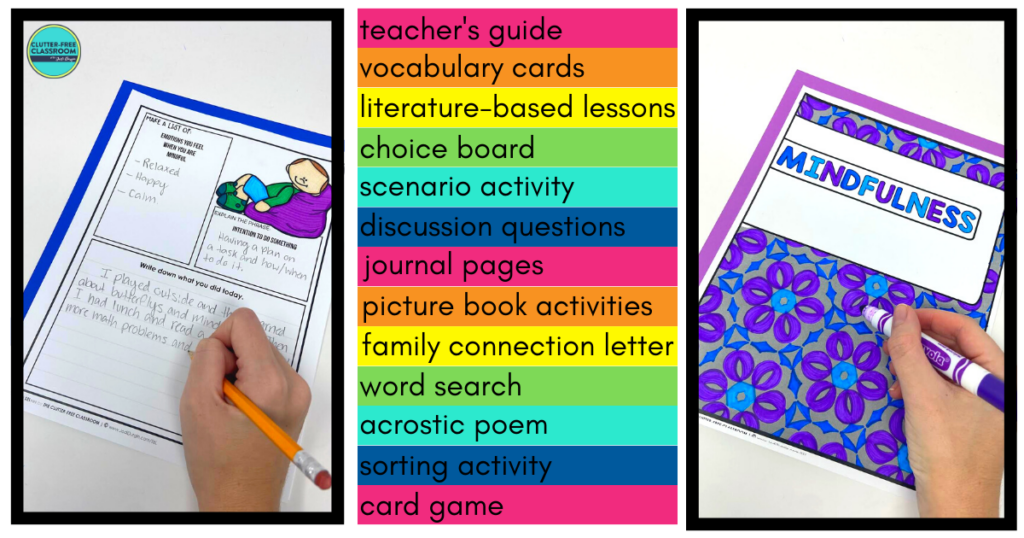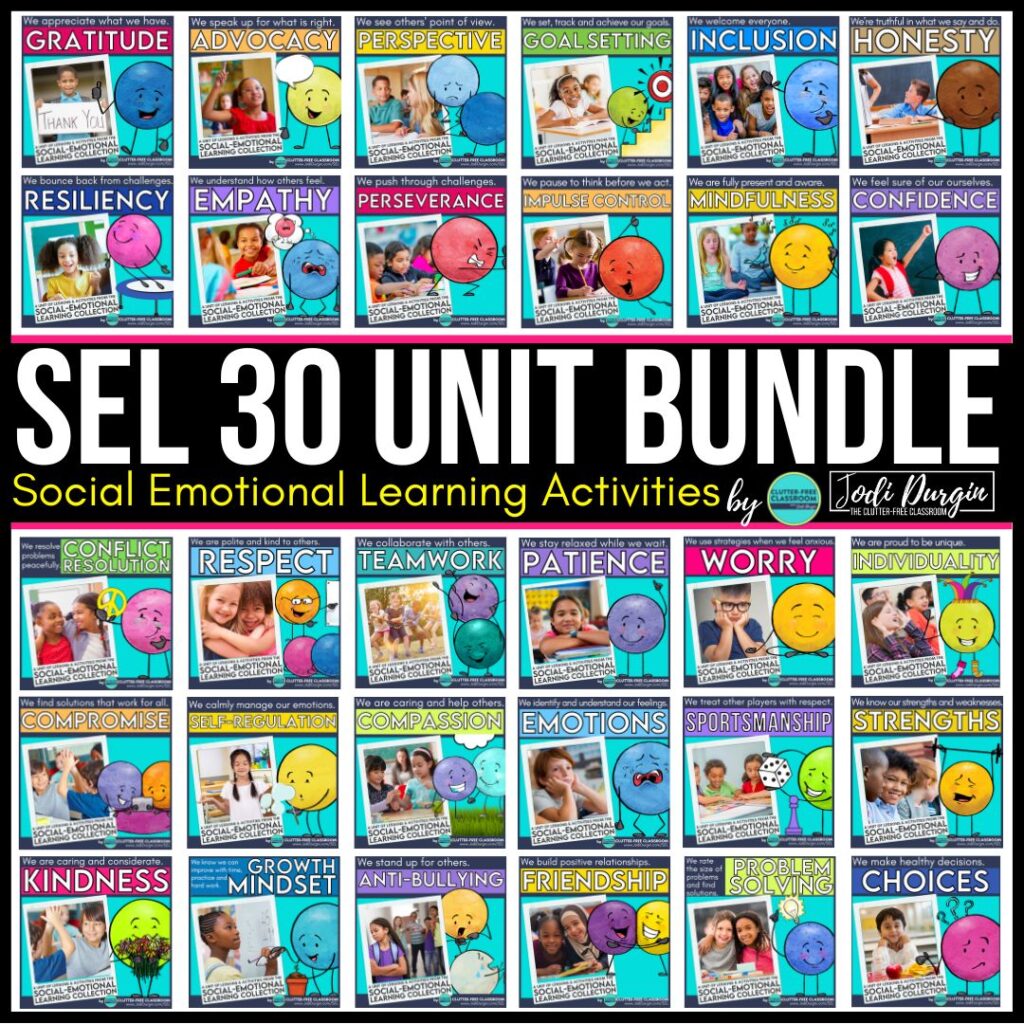If you are an elementary teacher looking to learn how to help your students practice mindfulness then you found the right place! Mindfulness skills prepare kids to slow down and think about the world around them. Students who are mindful are more in control and purposeful than students who are not. In this post, we’ll go into detail about what mindfulness is and why it’s important. In addition, we’ll share tips and ideas for how to teach mindfulness skills to elementary students in a classroom setting. Read all about helping students use mindfulness in and out of the classroom below!

What Does Mindfulness Mean?
Mindfulness means paying full attention to something and slowing ourselves down to really think about what we are doing. Mindfulness means being thoughtful about the world around you.
Why is it Important for Kids to be Mindful?
It is important for kids to be mindful because it helps them focus on what they are doing and be present and thoughtful throughout their day. Kids who are mindful can think clearly about decisions and make good choices. They think about how their words and actions affect others.


How Do I Know If I Need to Teach Mindfulness in My Classroom?
The elementary students in your 1st, 2nd, 3rd, 4th or 5th grade classroom would benefit from mindfulness lessons and activities if any of these statements are true:
- Students act quickly without thinking first.
- Students are trying to do too many things at one time.
- They have a hard time paying attention.
- Students are struggling to make good choices.
- Students have a hard time with their imaginations.


4 Reasons To Promote Mindfulness In Your Elementary Classroom
Below are 4 reasons to promote mindfulness for your elementary students in your classroom.
1. Students will become better listeners
Students who are practicing mindfulness will become better listeners because they will be working on paying full attention to what they are doing. This relates to paying full attention to listening to instruction and directions.
2. Students will be more thoughtful with their words and actions
Students who are mindful will be more thoughtful with their words and actions because they will care about the effect that they have on others. This will cause students to think about how others will feel before they speak and act. Students will also be reflective on what effect their words and actions had.

3. Students will be more engaged in their work
Students who are mindful will be more engaged in their work because they will be paying full attention to what they are doing. Kids practicing mindfulness will limit the distractions around them while they are working and use strategies for staying focused.
4. Students will better notice their emotions
Mindfulness helps students better notice the emotions that they are feeling. They will be better able to recognize when they start to feel an emotion and decide how they are going to regulate themselves. Learning mindfulness will also provide them with strategies for self regulation.


5 Tips and Ideas for Teaching Mindfulness
Below are tips and ideas for integrating mindfulness into your school day for your elementary students.
1. Read Aloud Picture Books about Mindfulness
Picture books are a great way to introduce and teach an SEL topic. It gets students thinking about the topic and activating their background knowledge. Check out this list of picture books for teaching mindfulness!
2. Watch Videos about Mindfulness
There are tons of free online videos out there that promote social emotional learning. It’s a fun and engaging way to teach SEL skills that your students will enjoy. Check out these videos for teaching mindfulness!

3. Explicitly Teach Vocabulary Related to Mindfulness
Vocabulary words can help students develop understanding of mindfulness and create connections through related words. Our mindfulness SEL unit includes ten vocabulary cards with words related to the SEL topic. It is important for students to be able to see, hear, and use relevant vocabulary while learning. One idea for how to use them is to create an SEL word wall as students learn the words.
4. Provide Practice Opportunities
When learning any skill, students need time to practice. Social emotional learning skills are no different! Our mindfulness SEL unit includes scenario cards, discussion cards, choice boards, games, and much more. These provide students with opportunities to practice the skills independently, with partners or small groups, or as a whole class.
5. Integrate Other Content Areas
Integrating other content areas with this topic is a great way to approach this SEL topic. Our mindfulness SEL unit includes reading, writing, and art activities.


Skills Related to Mindfulness
Mindfulness, in the context of social emotional learning (SEL) or character education, refers to the practice of paying attention to the present moment with intention, without judgment. While “mindfulness” is the commonly used term, there are other words and phrases that can convey a similar meaning. These alternative words highlight different aspects of present-moment awareness, focus, and nonjudgmental observation. Here are some other words used in the context of mindfulness:
- Present-moment awareness: Being fully engaged and attentive to the current experience and surroundings.
- Conscious presence: Cultivating a state of being fully present and aware of one’s thoughts, feelings, and sensations.
- Mindful awareness: Developing an intentional and nonjudgmental awareness of the present moment.
- Nonjudgmental observation: Observing and accepting thoughts, emotions, and experiences without evaluation or criticism.
- Attention training: Cultivating the ability to direct and sustain attention on the present moment.
- Focused awareness: Concentrating one’s attention and awareness on a specific object, task, or experience.
- Embodied presence: Bringing one’s attention and awareness into the body, noticing physical sensations and experiences.
- Centeredness: Establishing a sense of groundedness and balance in the present moment.
- Self-reflection: Engaging in introspection and self-examination with a nonjudgmental and curious attitude.
- Open awareness: Cultivating a spacious and inclusive awareness that embraces all experiences without preference or resistance.
These terms encompass the concept of mindfulness and reflect the qualities of present-moment awareness, nonjudgmental observation, and focused attention within the context of social emotional learning (SEL) or character education.


Download the SEL Activities
Click an image below to either get this individual mindfulness unit or get ALL 30 SEL units!
In closing, we hope you found this information about teaching mindfulness to your elementary students helpful! If you did, then you may also be interested in these posts.




